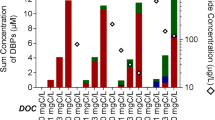Abstract
In the United States, the newly promulgated regulations for drinking water force water treatment utilities to be more concerned with finished and distributed water qualities. Water treatment utilities face new challenges with regard to maintaining disinfectants as well as reducing disinfection by-products (DBPs). The need to fulfill the more stringent DBP rules has stimulated scientific-based model development to represent in-plant and distribution-system DBPs. Numerous models for DBP formation, including trihalomethanes (THMs) and haloaceticacids (HAAs), have been proposed in recent decades, but these models simulation of full-scale DBP formation has not been significantly examined. In this study, which combines chemical DBP models (empirical power functional models) and hydraulic simulations, DBPs including THMs and HAAs were successfully simulated from full-scale monitoring data, indicating that the empirical DBP model offers a potential tool for accessing DBP formation in real plants. Modification of DBP prediction models using correction factors improved the accuracy of the DBP simulations.
Similar content being viewed by others
References
Amy, G., Siddiqui, M., Ozekin, K., Zhu, H-W. and Wang, C. (1998).Empirically-based Models for Predicting chlorination and Ozonation By-products: Haloacetic acids, Chloral hydrate and Bromate, EPA Report CX 819579
Book, J. J. (1974). Formation of Haloforms during Chlorination of Natural Waters,Water Treat. Exam., 23:234–243
Solarik, G., Summers, R. S., Sohn, J., Swanson, W. J., Chowdhury, Z. K. and Amy, G. L. (2000). Extensions and Verification of the Water Treatment Plant Model for DBP Formation, in Natural Organic Matter and Disinfection By-products,ACS, 47–66.
U.S. EPA (1998).National Primary Drinking Water Regulations: Disinfectants and Disinfection By-products; Final Rule, 40 CGR part 9, 141 and 142
Author information
Authors and Affiliations
Corresponding author
Additional information
The manuscript for this paper was submitted for review on September 20, 2001.
Rights and permissions
About this article
Cite this article
Sohn, J., Kim, HS. Modeling of chlorination disinfection by-products (DBPs) formation at the full-scale study. KSCE J Civ Eng 6, 89–100 (2002). https://doi.org/10.1007/BF02829039
Issue Date:
DOI: https://doi.org/10.1007/BF02829039




